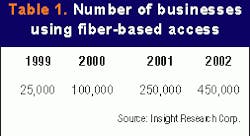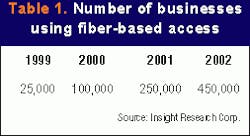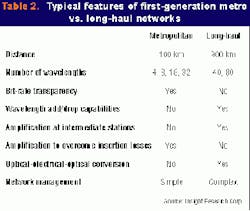Metro and access form the center of the capacity equation
As capacity grows in long-haul and enterprise spaces, metro and access network builders are desperately treading the bandwidth waters.
BY CHRISTOPHER WHITELY, Insight Research Corp.
Today, there are enormous capacities of bandwidth available in the core service-provider infrastructure and within enterprise networks. In the core network, DWDM has facilitated large-scale capacity expansions with protocol and bit-rate independence. The capacity of many enterprise LANs has also grown rapidly over the last few years, particularly with the introduction of Fast and Gigabit Ethernet technologies, which has made bandwidth within the corporate campus practically unlimited (and inexpensive).
Meanwhile, the central parts of the equation-the metropolitan and access networks-are struggling to keep up. With the growth of the Internet and data communications, long-haul networks are flooding metropolitan networks with increasing volumes of data, while access networks are being strained by the need to support demanding Web applications, virtual private networks, and other service offerings.
As campus networks begin to run at gigabit speeds, access networks must carry native traffic at the same speeds between remote enterprise sites, storage-area networks (SANs), and other corporate partners. In particular, the success of application service providers will require a highly flexible, high-capacity metropolitan network, as servers move from residing on the LAN to data centers along the metro network. As the number of businesses using fiber-based access grows from 25,000 in 1999 to more than 450,000 in 2002 (see Table 1), demand for gigabit speeds will only increase in the future.Unfortunately, these speeds are not widely available in service-provider networks, and when they are, they are often too expensive. While many more companies need access at OC-3 (155-Mbit/sec) speeds and above, few are willing to pay $15,000 to $55,000 per month for that access, as has been required in the past.
The crisis in metropolitan-area bandwidth availability is coming at a time when, after being battered by the current technology bear market, carriers have less money to spend on infrastructure than just several months ago. To adjust for these spending constraints and still meet customer demand, a thorough examination of metro DWDM vendor of ferings becomes even more crucial to ensure service providers get the most "bandwidth for their buck."
The metropolitan market's need for an appropriate transmission solution is fairly clear. The following elements are important:
- Low cost. Any viable solution must have a low initial cost. Lifecycle costs must also be kept low through efficient engineering, operations, and training.
- Capacity. Solutions must have sufficient capacity to accommodate customers' communications traffic.
- Scalability. Carriers must have the ability to incrementally increase network capacity in response to customer demand.
- Flexibility. There must be the ability to support multiple architectures (point-to-point, ring, and mesh), route traffic, make capacity adjustments depending on traffic levels, and add/drop individual signals at any point of presence on the network.
- Survivability. There needs to be a means to monitor and manage wavelengths in the event of a network failure and a means to recover from failures in under 50 msec.
- Interoperability. The solution must allow new equipment to work smoothly with older equipment, such as SONET multiplexers, ATM switches, and Internet Protocol (IP) routers, as well as network-management systems. The equipment should be able to provide native protocol support for all traffic.
Because of these differences, vendors agree that metro DWDM systems cannot be "dumbed down" long-haul systems. For one thing, the cost advantages offered by DWDM do not always extend to metro markets. In a long-haul system, by increasing the number of channels that can share a single fiber, fewer optical amplifiers are needed to boost the signal between distant nodes. Doing that is much cheaper than using several fibers, each with its own string of optical amplifiers.
Because metro networks are short enough to do without any optical amplification in intermediate stations, they cannot benefit significantly from the major cost advantage for DWDM-based long-haul links-a common repeater for all wavelengths. As a matter of fact, the use of DWDM in a metropolitan setting often requires additional optical amplification (that would not be necessary in a long-haul system) to compensate for insertion losses caused by the DWDM hardware. As a consequence, first-generation metro DWDM systems have been expensive to buy, install, and maintain.
Another problem with first-generation metro DWDM systems has been an inherent lack of flexibility. Most systems lacked easily changeable add/drop and remote reconfiguration features that are needed to manage dynamic metropolitan traffic patterns. Also, products typically have not had the ability to support multiple network topologies (point-to-point, ring, star and mesh).
The lack of optoelectronic conversion capability has also limited metro system manageability. Present-day long-haul DWDM systems perform expensive optical-electrical-optical (OEO) conversion on each wavelength at each node. To reduce the cost, metro DWDM systems are generally offered without OEO capability. However, without optoelectronic conversion, metro DWDM systems that rely on optical filters to pass through wavelengths at a node have no way of providing performance monitoring on those wavelengths, giving carriers no way of isolating faults between offices.
The lack of regeneration at each node makes the network more difficult to plan. Network engineers become more concerned with accumulated jitter and signal degradation as the number of nodes in the network increases. For this reason, most metro DWDM systems are limited in the number of nodes in a ring that can be supported as well as the total circumference of the ring. As a result, networks have to be carefully laid out in advance, with planners accurately predicting the future behavior of traffic patterns.
Because of these problems, today's carriers have preferred to deploy SONET/ SDH solutions. These systems are mature, lower the cost, and provide a highly reliable, carrier-class architecture. However, most industry participants agree that SONET/SDH, designed primarily for transporting multiplexed voice, is insufficient to scale to meet the needs of the next-generation, data-centric network. Thus, even the next-generation SONET/SDH equipment is incorporating DWDM functionality.
So the search for the ideal metropolitan transmission system continues, with next-generation SONET/SDH, next-generation DWDM, fixed wireless, and optical frequency-division multiplexing (OFDM) solutions becoming rivals for the attention of local-exchange carriers. The successful deployment of DWDM in metro networks hinges partly on cutting the cost of upgrading capacity to accommodate higher traffic levels as well as increasing performance and flexibility. The top metro DWDM vendors are all taking steps to address these concerns. Several examples include:
- Cost and capacity. Total costs for the service provider and customer will be lowered as 10-Gigabit Ethernet, rate-adaptive Gigabit Ethernet, and bandwidth-on-demand systems become available.
- Flexibility. Vendors are building Ethernet, SONET, Escon, and Fibre Channel ports into metro systems. Wavelength management tools are allowing providers to assign aggregate LAN and SAN traffic to particular wavelengths to build distributed SAN farms within a metropolitan radius.
- Performance. Many DWDM developers are focusing on reducing insertion loss via extended-reach transceivers and thin-film filters. That is especially important for metro network providers, because a 1-dB decrease in component insertion loss can lead to a 40% increase in metro-area coverage.
In the future, Insight Research expects to see even more flexibility in metro DWDM products, as new components, tunable lasers and filters, wavelength converters, and all-optical systems emerge on the market. Higher wave counts and port densities will also arrive shortly.
Potential metro DWDM system buyers must look for systems addressing the general needs mentioned above, while taking into consideration the specifics of their implementation. What is the system being used for? If it is simply for the transport of high volumes of traffic, a very flexible system may not be as important as a system with high capacity and reliability. Yet, since flexibility is an important feature in the long run, it may be a mistake to forsake systems with multiple functions just to buy a slightly lower-priced system with limited functionality. Products must dovetail neatly within the buyer's long-term network build-out plans.
Buyers must also be very careful to distinguish the marketing hype from actual product performance. As one Internet service-provider executive aptly put it, "I don't approve [vendor's products] because they have PDFs [portable document formats] that say their boxes are cool." Product testing, benchmarking, and trusted referrals are all important steps in the purchasing process. A company also should not go with a vendor just because they seem to be a market leader, although there often is a reason for the vendor's position.
Some additional questions to consider include:
- What is the software element manager that comes with the product? Can the system be managed by a multivendor network-management system? Can the bandwidth be easily provisioned for each new customer that comes onto the network?
- How old is the product? (Something too old may rapidly be obsolete, while something too new may be based on untested technology.)
- Can the product easily fit into the carrier or collocation facility?
- Does the vendor provide financing? What are the terms of the financing?
The larger DWDM system vendors all have solutions designed specifically for the metropolitan market, and many of them address some of the concerns mentioned here.
Nortel Networks' (Brampton, Ontario) product is the OPTera Metro multiservice platform series. In particular, the OPTera Metro 5100 and 5200 Multiservice Platforms (formerly OPTera Metro 20/80) address many of the major concerns noted above. The ring and optical add/drop multiplexer capabilities of OPTera Metro 5100 and 5200 allow wavelengths to be added and dropped at each node on the ring. Also, the ring architecture ensures network survivability by protecting services at the optical layer. Service providers can enable standard 50-msec protection switching on a per-wavelength basis to provide optical-layer survivability by routing signals around fiber failures. The service provider can choose which wavelengths need to be protected and which should run unprotected. The 5000 Series supports up to 32 protected (64 unprotected) wavelengths across either a point-to-point or ring network.
Analyst firm rankings typically place Ciena Corp. (Linthicum, MD) second in metro DWDM market share behind Nortel (and fifth or sixth in long-haul DWDM market share). The company has had a first-generation metro product called Firefly for some time now. This is a point-to-point system designed more for metro DWDM access. Its product introduced in 1998, the MultiWave Metro, can handle different topologies (ring, star, mesh, point-to-point), provide protection switching, and add/drop single channels. The Metro product provides up to 24 duplex channels over a single fiber pair, enabling the fiber to carry up to 60 Gbits/sec. In the future, Ciena's OnCenter management product will allow multivendor provisioning across the network. Ciena's merger with Cyras, announced last December, is an attempt to broaden its metropolitan product portfolio.
ONI Systems Inc. (San Jose, CA) has developed what it calls the Dynamic Transport System (DTS), composed of an optical-network operating system and an optical link management protocol suite, designed for data-centric wavelength-routed metro services. The DTS allows carriers to dynamically provision services, allocate capacity on demand, and provide multiple levels of service. Very similar to Ciena's Metro solution in terms of functionality, ONI's metro platform (the ONLINE9000) supports 10-Gbit/sec channels, and SONET, Gigabit Ethernet, Escon, and Fibre Channel traffic.
Cisco Systems' (San Jose) optical-networking sales to date have mostly been in the area of SONET equipment, though the company does have a rapidly developing portfolio of DWDM equipment. The May 2000 Qeyton Systems Inc. acquisition enhances Cisco's metro DWDM offerings by enabling the company to offer products for service providers as well as enterprises. There are significant differences between the Metro 1500, aimed at enterprises, and the Qeyton products, aimed at service providers. Primarily, the Metro 1500 is geared strongly toward storage applications. To meet this focus, the Metro 1500 has a set of Escon and Fibre Channel interfaces-especially Escon, which accounts for about 80% to 90% of the enterprise DWDM market. (Escon, Fibre Channel, and coupling link interfaces generally run point-to-point networks.) In contrast, the Qeyton products are more suitable for ring topology, with two, three, or four nodes on the ring. The Qeyton products are dominated by Gigabit Ethernet and SONET interfaces, making them more useful for carriers. In terms of physical differences, the Qeyton products support 16-wavelength multiplexing, while the Metro 1500 supports 32-wavelength multiplexing.
Sycamore Networks Inc. (Tewksbury, MA) provides carrier-class optical-networking platforms, including transport systems, optical switches, and management systems. The transport nodes include the SN 8000, designed for a mixed access, metro, and long-haul environment. The software-centric SN 8000 allows the "point and click" provisioning of new services, including SONET/SDH, Gigabit Ethernet, Fibre Channel, and Escon, using management software and soft optics.
The other major network equipment vendors also have solutions for the metro network. Lucent Technologies (Murray Hill, NJ) remains a major player in optical networking, with its WaveStar OLS 40 and OLS 80 products being applicable to both metro and long-haul networks. Lucent will probably introduce a next-generation DWDM product derived from its acquisitions of Ignitis Communi cations LLC and Chromatis Networks (Bethesda, MD) sometime this year-but that remains to be seen.
Marconi Communications' (Pitts burgh) SmartPhotoniX PMM supports metro networks with a circumference of up to 20 km in a non-amplified configuration, and 200 km with optical amplification. The PMM equipment supports up to 2.5-Gbit/sec bit rates and has multiple-channel add/drop functionality.
Other vendors include Alcatel (Paris), Fujitsu (Tokyo), and Ericsson (Stock holm). One of the earliest vendors to clearly articulate a vision of the all-optical network, Alcatel offers regional and access versions of its Optinex product.
A number of innovative solutions for the metro network are coming from lesser-known, smaller companies.
LuxN Inc. (Sunnyvale, CA) launched its WavFarer and WavPortal access systems as an alternative to edge routers (for aggregation of LAN traffic) and access multiplexers (for aggregation of voice traffic). LuxN is concerned with providing inexpensive access systems to service providers, primarily competitive local-exchange carriers, which offer managed optical services for enterprise networks. The company's optical access applications accommodate Gigabit Ethernet LAN interconnection, Fibre Channel extension, SANs, upgrades to legacy SONET and ATM enterprise backbones, and Internet connectivity for locally hosted, high-traffic Web servers.
Mayan Networks' (Sunnyvale, CA) Unifier SMX is a SONET-based access platform designed for the network edge. The system uses SONET/ SDH transport for data and voice, and aggregates, routes and switches time-division multiplexing (TDM), frame relay, IP, and ATM traffic. The Unifier performs many of the functions commonly relegated to SONET/ SDH ADMs, digital crossconnects, frame relay switches, ATM switches, IP routers, and voice-over-IP gateways.
Quantum Bridge Communications Inc. (North Andover, MA) markets a transport system for passive-optical-network-based access networks. The system consists of an optical access switch and intelligent optical terminal for fiber-to-the-business service delivery, covering TDM SONET, ATM-over-SONET, packet-over-SONET, DWDM, and Gigabit Ethernet WAN traffic. Quantum Bridge has attempted to extend the benefits of DWDM through its dynamic wavelength slicing (DWS). The DWS protocol makes it possible for providers to allocate a desired bandwidth within a given wavelength for more efficient use of resources. The provider can dedicate an entire wavelength to a single business or user or slice a single wavelength so that it may be shared among a number of businesses or end users. The latter is accomplished by extending the capacity and number of terminations served by the wavelength.
Appian Communications Inc. (Box borough, MA) targets the metro bottleneck with its Optical Service Activation Platform (OSAP), meant to replace inflexible TDM networks. The difficulty with TDM, according to the company, is that users are unable to allocate bandwidth efficiently, either getting too much or too little, therefore restricting them to the traditional TDM service speeds of 1.5 Mbits/sec, 45 Mbits/sec, 155 Mbits/sec, etc. The OSAP allows software-tunable bandwidth allocation at levels between the TDM service speeds. The company's OSAP 4800 is designed for multitenant buildings, office parks, and dense urban central-office locations.
MRV Communications (Chatsworth, CA) is producing a product for wide-area and metro networks that is based on coarse wavelength-division multiplexing (CWDM). CWDM offers an aggregate 10-Gbit/sec bandwidth inexpensively by transmitting eight streams of data on a fiber at distances up to 40 km and beyond. With more widely spaced wavelengths, much of the DWDM infrastructure can be eliminated or replaced with cheaper alternatives. CWDM transmits four channels using four wavelengths in the 1.5-mm low-loss window.
The 15 companies mentioned here are not intended to be a definitive list of metro equipment providers-the number of companies targeting this space seems to grow monthly. For carriers, that means the number of choices-and the complexity of making the right equipment choice-promises to increase in the coming year.
Christopher Whitely is project manager for Insight Research Corp. (Parsip pany, NJ). He can be reached at [email protected]. Material for this article was drawn from Insight Research's upcoming report entitled "DWDM, SONET and Photonics: The Emerging All-Optical Network 2000-2005."


